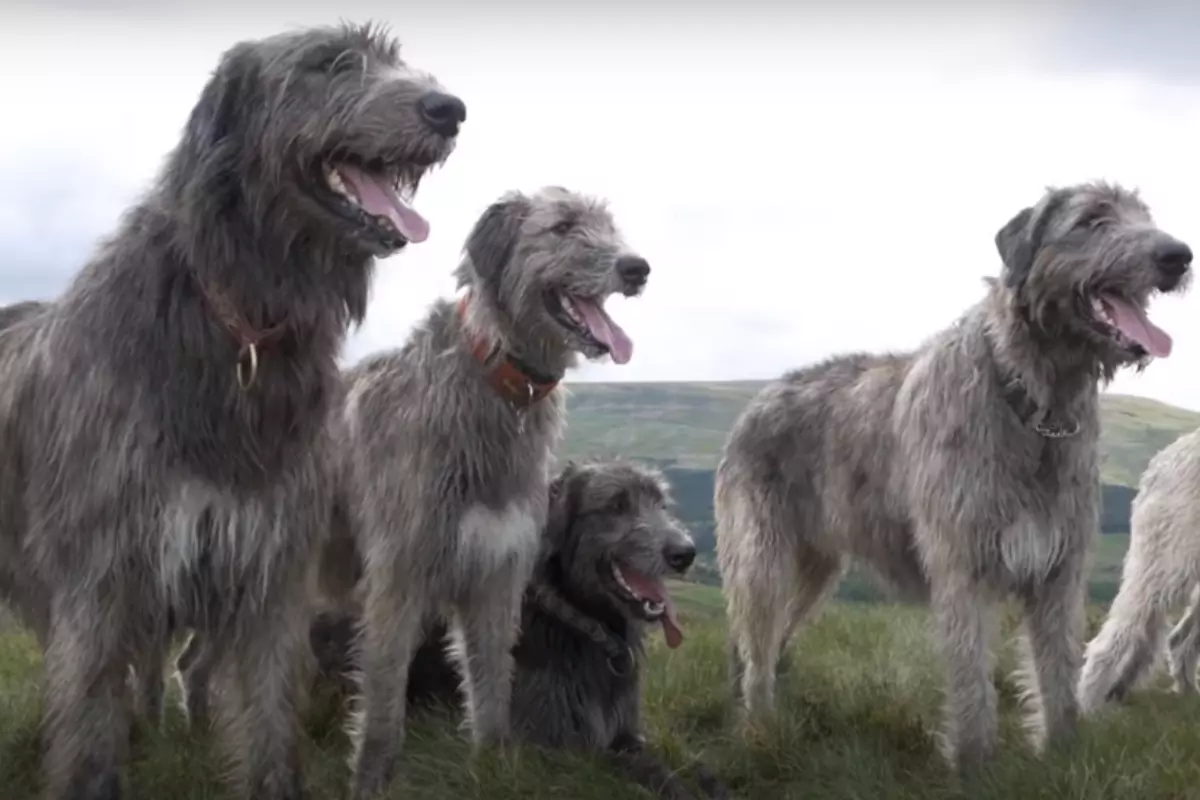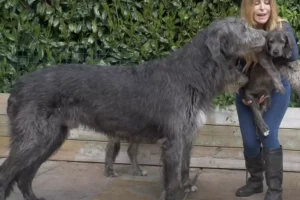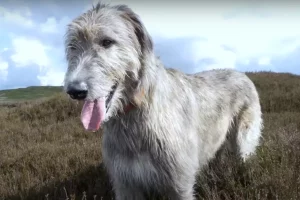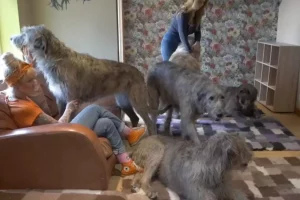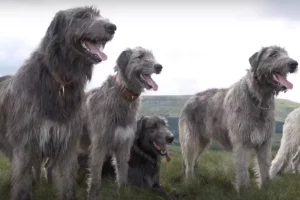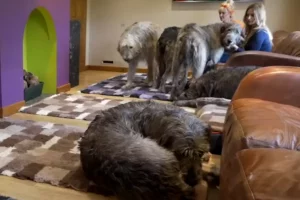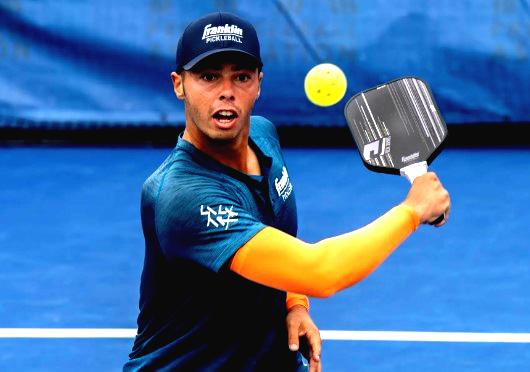Introduction
Dogs come in many forms and sizes, have various personalities, and perform a variety of tasks. But there’s one special dog we want to talk about, the Irish Wolfhound. It’s not just big; it’s also very kind and noble. Let’s explore more about these amazing dogs, who happen to be the tallest breed in the world.
A Brief History of Irish Wolfhounds (Tallest Dog Breed)
Origins and Early Uses
A long time ago, in ancient Ireland, people made Irish Wolfhounds. These dogs were very brave and strong. They had an important job: to help hunt wolves and big Irish elk. That’s why they got the name “Wolfhound.”
These special dogs weren’t just great hunters. They were also like fancy presents for important Irish leaders. Sometimes, they gave these dogs to kings and queens from other places. People from far away heard about these amazing dogs, too.
Near Extinction and Revival
In the late 1800s, the Irish Wolfhound almost disappeared in Ireland. A few things caused this. Wolves were gone, there was a big famine in 1845, and they gave these dogs as gifts to important visitors.
Physical Characteristics Of The Tallest Dog Breed
Impressive Size and Build
The tallest breed of dog “Irish Wolfhound” is known for being very big. Grown-up boy dogs are usually at least 32 inches tall, and girl dogs are about 30 inches tall. Some of them can even be taller, especially the boys, who can reach 36 inches.
These big dogs are strong but also move fast. They have long legs, not-too-wide bodies, and slightly curved backs. They look really graceful because of their deep chests and slim waists.
Coat and Color
Irish Wolfhounds have two layers of fur, and it feels stiff and straight. Their fur is not too short or too long; it’s just right, and it can be different colors like gray, brindle, red, black, white, or fawn. What makes them special is they have long eyebrows and a beard on their face, which makes them look very noble.
Grooming
Taking care of an Irish Wolfhound’s fur is not too hard. You should brush their fur often to get rid of loose hairs. And twice a year, it’s a good idea to gently pull out the dead hair to keep them looking nice. The best part is they don’t lose a lot of fur, so if you’re worried about allergies, they’re a good pick.
You can also read Tallest buildings in California State.
Personality and Temperament Of The Tallest Dog Breed
Gentle Giants
Irish Wolfhounds are famous for being kind and calm dogs. They have really big hearts, and they act in a noble and caring way. Even though they are super big, they like to take things slow and don’t always follow orders as quickly as smaller, more active dogs.
Interaction with Other Animals
Big Irish Wolfhounds are usually very good when they meet other dogs, pets, and children. They feel okay around kids and other dogs, especially if they learned how to be friendly when they were little.
But there’s something important to remember. Irish Wolfhounds really like to chase small animals like cats or squirrels when they go for walks. They don’t mean to be mean, but because they are so big and strong, it can be tough to stop them when they start chasing.
Behavior and Alertness
Irish Wolfhounds don’t bark a lot, but if something strange is going on, they will let you know. Some of them might get very worried if they are left alone for a long time, so it’s a good idea not to leave them by themselves for too many hours. Giving them things to do and keeping them active can help them feel better and not get so anxious.
Training
Training Irish Wolfhounds is easy because they are sensitive and want to make you happy. It’s best to use nice ways to teach them, like giving them treats when they do well. It’s not a good idea to be rude or yell at them because that could make them feel terrible and make them not want to study. They like it when you’re patient and gentle when teaching them things.
Living with Irish Wolfhounds
Space Requirements
If you’re thinking of having an Irish Wolfhound, the most important thing to remember is that they are really, really big dogs. They need a lot of space to move around and feel good. They take up more room than most other dogs, so you have to think about how they’ll fit in your car, how you can keep them under control, and what you’d do if they ever got sick or hurt.
Preference for Cold Weather
Irish Wolfhounds like cold weather more than hot weather. In the summer, they might look for cold, hard places to lie down. But this can make rough spots on their elbows called calluses. Calluses can make them uncomfortable and not look very nice.
Health Considerations
Irish Wolfhounds, like many giant breeds, are prone to certain health issues. These include:
- Gastric Dilatation-Volvulus (Bloat, GDV): a serious ailment that calls for emergency veterinarian help. A deeper-chested senior dog may be more prone to it.
- Bone Cancer (Osteosarcoma): An aggressive bone cancer that Irish Wolfhounds are predisposed to. Early diagnosis and treatment are crucial.
- Hip Dysplasia and Elbow Dysplasia: Conditions that affect the joints and can lead to pain and lameness. Treatment varies depending on the severity.
- Dilated Cardiomyopathy (DCM): A serious heart condition that requires intensive treatment.
Shorter Lifespan
Irish Wolfhounds, on average, live about 6 to 8 years, which is a relatively short lifespan when compared to lesser breeds. This is a consideration for potential owners who should be prepared for the emotional challenge of their dog’s shorter life expectancy.
Nutrition and Feeding Of The Tallest Dog Breed
Special Dietary Needs
When you’re feeding an Irish Wolfhound, you have to think about what’s best for them. If they’re puppies and they’re really big, they need to grow at the right speed so their bones and muscles grow strong. If they grow too fast, their bones and joints might not be okay, and they could have problems like hip dysplasia and elbow dysplasia.
Feeding Schedule
For grown-up Irish Wolfhounds, it’s good to give them food two times a day, with about 12 hours in between. Don’t use raised bowls for their food and water because that might make them more likely to get a dangerous problem called bloat.
Advantages And Challenges Of the Tallest Dog Breed
Advantages of Irish Wolfhounds
Challenges of Irish Wolfhounds
- Gentle and friendly temperament.
- Loyal and devoted companions.
- Impressive and majestic appearance.
- Low shedding coat.
- Moderate exercise needs.
- Enormous size requires ample space.
- Shorter lifespan (6-8 years).
- Health concerns like bloat and cancer.
- Strong prey drive can lead to chasing.
- Not suited for apartment living.
- Higher cost of care due to size and health needs.
Advantages of Irish Wolfhounds
- Gentle and friendly temperament.
- Loyal and devoted companions.
- Impressive and majestic appearance.
- Low shedding coat.
- Moderate exercise needs.
Challenges of Irish Wolfhounds
- Enormous size requires ample space.
- Shorter lifespan (6-8 years).
- Health concerns like bloat and cancer.
- Strong prey drive can lead to chasing.
- Not suited for apartment living.
- Higher cost of care due to size and health needs.
Conclusion
In the dog world, the Irish Wolfhound is a big deal, both in size and in how special they are. They’re huge, kind, and have a really interesting history. Even though they need extra care because they’re so big and might have health problems, having one as a friend is totally worth it. If you want a dog that’s majestic but also really gentle, the Irish Wolfhound could be just what you’re looking for.
If you want read more about Tallest bodybuilder / Tallest building in San Francisco and many more articles kindly click the link.
FAQs
What is the average lifespan of an Irish Wolfhound?
Irish Wolfhounds typically live for about 6 to 8 years.
Do Irish Wolfhounds shed a lot?
No, Irish Wolfhounds have a low-shedding coat, which means they don’t shed excessively.
What is the tallest dog breed?
The Irish Wolfhound holds the title for the tallest dog breed, known for its impressive height and noble appearance.

